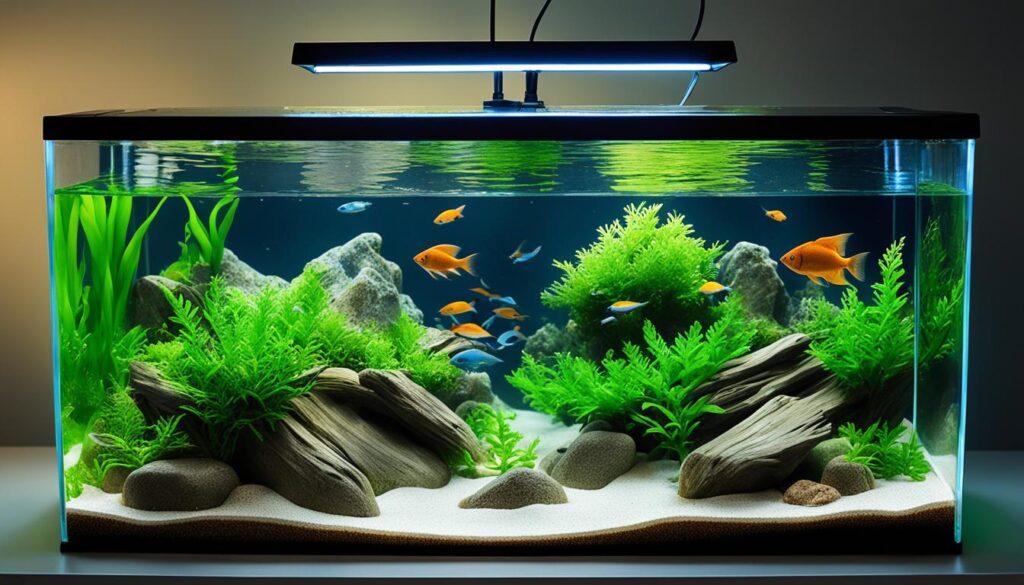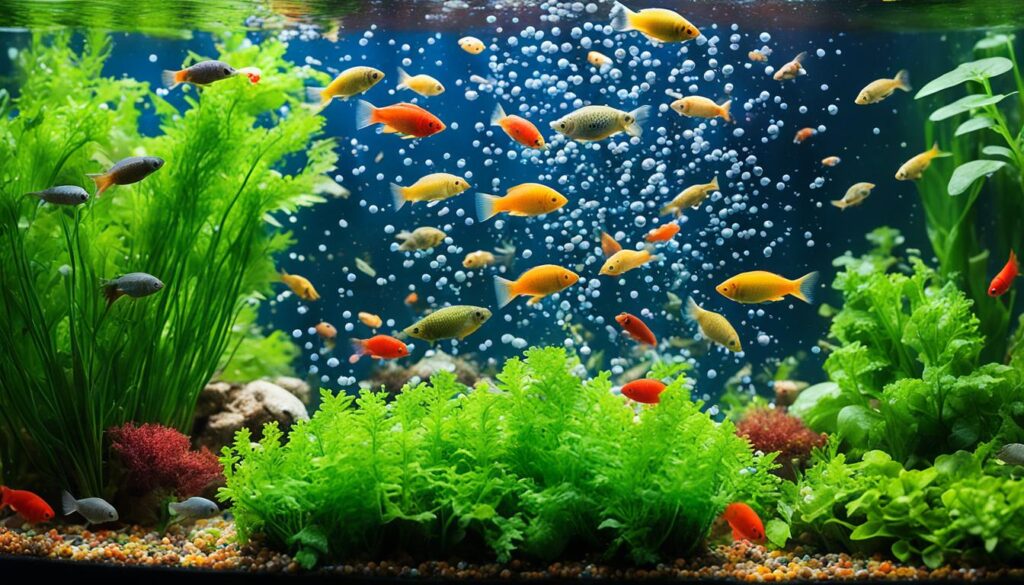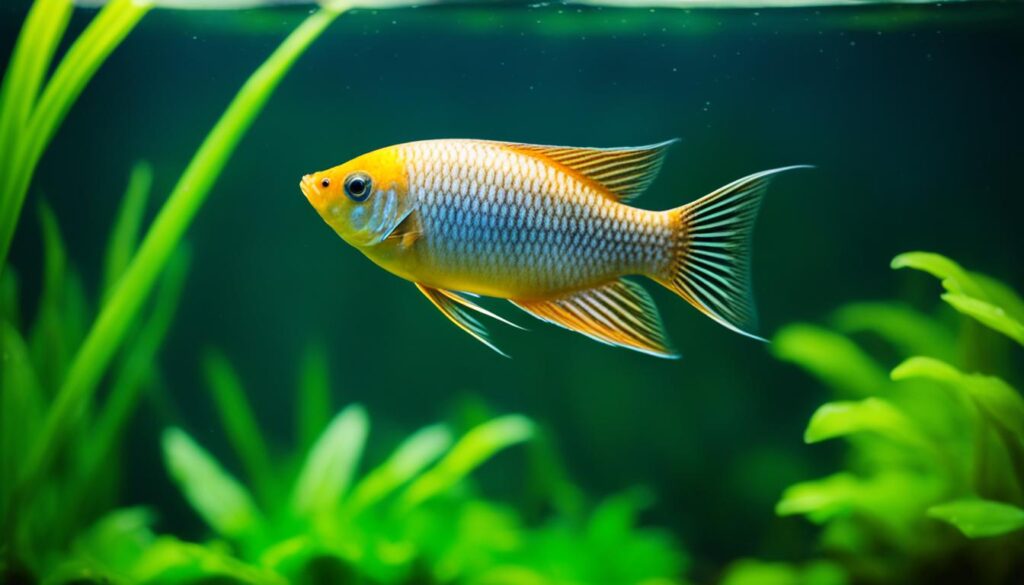Are you ready to dive into the fascinating world of honey gouramis? These brightly colored freshwater fish, scientifically known as Trichogaster chuna, are not only stunning to look at but also make great additions to community aquariums. But how do you ensure their health and well-being? In this care guide, we will provide you with essential tips and insights to keep your honey gouramis thriving.
Let’s start by exploring the unique characteristics of honey gouramis. Did you know that they have a labyrinth organ, allowing them to absorb oxygen directly from the air? This means they can adapt to a wide range of water conditions. But what else do they need to thrive?
In this guide, we will cover everything from tank setup and diet to compatible tank mates, breeding, and behavior. By the end, you’ll have all the knowledge you need to create a healthy and harmonious environment for your honey gouramis.
Key Takeaways:
- Learn the essential tips for keeping honey gouramis healthy and happy.
- Discover the unique features of honey gouramis, including their ability to breathe atmospheric oxygen.
- Find out how to set up the perfect aquarium for honey gouramis.
- Understand the balanced diet requirements of honey gouramis.
- Explore the fascinating world of honey gourami breeding and behavior.
What are Honey Gouramis?
Honey gouramis, also known as Trichogaster chuna, are small, oblong-shaped fish that belong to the gourami family. They are similar in appearance to betta fish, with vibrant coloration and flowing fins. The males display brighter colors, featuring shades of honey, orange, and red, while females tend to be more subtly colored. These stunning fish can add a touch of elegance to any aquarium.
Lifespan and Size
The honey gourami has a relatively moderate lifespan compared to other fish. On average, they can live between 5 to 8 years under suitable conditions. As for their size, honey gouramis reach an adult length of approximately 2 inches. Despite their small stature, they have a commanding presence in the tank.
Peaceful Temperament and Compatibility
Honey gouramis are known for their peaceful temperament, making them suitable for community aquariums. They coexist harmoniously with a variety of other fish species, as long as the tankmates share a similar demeanor. It’s important to avoid aggressive or fin-nipping fish that may cause stress to the honey gouramis.
When selecting tank mates for honey gouramis, consider peaceful species that occupy different areas of the tank. By providing a diverse range of fish that occupy various levels of the aquarium, you can maximize the space available to all inhabitants. Common tank mates include:
- Tetras
- Cory catfish
- Rasboras
- Some species of livebearers
Honey gouramis also display interesting behaviors, such as their ability to breathe atmospheric oxygen using a specialized labyrinth organ. This allows them to occasionally swim to the water surface and gulp air. It’s a fascinating trait that highlights their adaptation to their natural environment.
If you’re considering adding honey gouramis to your aquarium, it’s essential to provide them with suitable tank conditions, a balanced diet, and compatible tank mates. By giving them the care they need, you can enjoy the beauty and grace of these captivating fish for years to come.
| Honey Gourami Characteristics | |
|---|---|
| Scientific Name | Trichogaster chuna |
| Common Names | Honey gourami, red honey gourami, dwarf gourami |
| Size | Around 2 inches |
| Lifespan | 5-8 years |
| Temperament | Peaceful |
| Water Parameters | pH 6.0-8.0, temperature 74-82°F |
Note: The table above summarizes the key characteristics of honey gouramis.
Setting Up an Aquarium for Honey Gouramis
To provide a suitable habitat for honey gouramis, it is important to set up their aquarium properly. Follow these tips for a successful honey gourami tank setup:
1. Tank Size and Space
A 20-gallon tank is recommended for a group of honey gouramis, as they prefer plenty of space to swim and explore. This tank size allows them to exhibit natural behaviors and reduces the likelihood of territorial disputes.
2. Decorations
Decorate the tank with live plants, rocks, and driftwood to mimic their natural environment. Honey gouramis appreciate hiding spots, so provide caves or dense vegetation where they can retreat when needed. This will help reduce stress and make them feel secure.
3. Water Temperature and pH
Maintaining stable water conditions is crucial for the health of your honey gouramis. The recommended temperature range is between 74-82°F (23-28°C). Additionally, honey gouramis can tolerate a pH level between 6.0-8.0.
4. Filtration and Water Quality
Ensure proper filtration to maintain good water quality. A gentle filter flow is preferred as honey gouramis are not strong swimmers. Perform regular water changes to keep nitrate levels low and maintain a healthy environment for your fish.
5. Compatible Tank Mates
Honey gouramis are peaceful fish and can coexist with a variety of tank mates. Here are some suitable honey gourami tank mates:
| Tank Mate | Notes |
|---|---|
| Neon Tetras | Peaceful schooling fish that add color to the aquarium. |
| Cory Catfish | Bottom-dwelling fish that help keep the tank clean. |
| Loaches | Active and social fish that can coexist with honey gouramis. |
Remember to research the specific needs and temperament of any potential tank mate to ensure compatibility with honey gouramis. Avoid aggressive or fin-nipping fish that may cause stress or harm to your honey gouramis.
With the right honey gourami tank setup, your fish will thrive and create a harmonious environment in your aquarium.

Continue reading the next section to learn about the diet of honey gouramis and how to provide them with a balanced and nutritious meal.
Honey Gourami Diet
Honey gouramis are omnivorous fish and have a flexible diet. In their natural habitat, they feed on small bug larvae, crustaceans, and other invertebrates. In an aquarium, they can be fed a variety of foods, including:
- Flake and pellet food
- Freeze-dried and frozen foods
- Live foods such as brine shrimp and daphnia
Providing a balanced diet is essential to keep the honey gouramis healthy and vibrant. It is important to feed them a variety of foods to ensure they receive all the necessary nutrients. Feeding should be done in moderation to prevent overfeeding and maintain good water quality.
| Food Type | Description |
|---|---|
| Flake and pellet food | A staple diet that provides essential nutrients |
| Freeze-dried and frozen foods | Offers variety and mimic natural prey |
| Live foods (brine shrimp, daphnia) | Rich in protein and stimulates natural foraging behavior |
Remember to observe the fish during feeding to ensure they are eating well and adjust the amount of food accordingly. Providing a diverse diet will help maintain the overall health and vitality of your honey gouramis.

Breeding Honey Gouramis
Breeding honey gouramis can be a fascinating experience. These beautiful fish can reproduce in the controlled environment of a breeding tank, allowing you to witness the miracle of life up close. To successfully breed honey gouramis, it’s important to create the right conditions and provide proper care for the breeding pair.
Setting up the breeding tank:
Start by setting up a separate breeding tank with suitable conditions. The breeding tank should have a stable temperature of 82°F and a pH level ranging from 6.0 to 6.5. Maintain a clean and well-filtered environment to ensure the health and safety of the breeding pair.
Introducing the breeding pair:
Choose a healthy male and female honey gourami to introduce to the breeding tank. It’s important to provide them with a high-quality diet to condition their bodies for the breeding process. This will help ensure successful mating and the production of viable eggs.
The breeding process:
The male honey gourami will take the lead in the breeding process. He will build a bubble nest at the water surface using saliva and bubbles, which serves as a safe haven for the eggs. The female will then release her eggs, and the male will swiftly follow to fertilize them. The male will carefully place the eggs in the bubble nest to protect them from predators and ensure their survival.
Caring for the fry:
Once the eggs hatch, they will emerge as small, transparent fry. At this stage, it’s crucial to provide them with proper nutrition for healthy growth. Feed the fry with small foods such as infusoria and baby brine shrimp to meet their nutritional needs. Monitor water quality closely and perform regular water changes to maintain optimal conditions for the fry’s development.
Monitoring and separating the fry:
As the fry grow, it’s essential to monitor their progress and separate them from the breeding tank once they reach a certain size. This prevents overcrowding and minimizes the risk of aggression or predation among the fry. Move them to a separate rearing tank and continue to provide them with appropriate diet and care.
Enjoying the rewards:
Breeding honey gouramis can be a rewarding and fulfilling experience. Watching the entire process unfold, from the construction of the bubble nest to the hatching and growth of the fry, offers a unique opportunity to witness the wonders of nature. With proper care and attention, you can successfully breed honey gouramis and contribute to the population of these captivating fish.
| Advantages of Breeding Honey Gouramis | Challenges of Breeding Honey Gouramis |
|---|---|
|
|
Honey Gourami Behavior
Honey gouramis are fascinating fish with unique behaviors that make them a delightful addition to any aquarium. Let’s explore some of their captivating behaviors:
- Gulping Air: One distinct behavior of honey gouramis is their habit of gulping air from the water surface. This behavior is made possible by their labyrinth organ, which allows them to absorb atmospheric oxygen. It’s an incredible adaptation that enables honey gouramis to breathe even in oxygen-deprived water conditions.
- Active Swimmers: Honey gouramis are known for their active swimming habits. They prefer to explore the middle and upper layers of the aquarium, creating a lively and vibrant display. This behavior adds a sense of energy and movement to your tank.
- Shoaling Fish: Honey gouramis thrive in the company of their own kind. They are shoaling fish, which means they prefer to be kept in groups rather than as solitary individuals. By keeping a small group of honey gouramis, you can witness their social interactions and observe their playful behavior.
“The gulping behavior of honey gouramis is truly remarkable and showcases their incredible adaptation to diverse aquatic environments.” – Aquarium Expert
When it comes to tank mates, honey gouramis are compatible with other non-aggressive fish that share their peaceful nature. They provide a harmonious presence in a community tank, contributing to the overall tranquility and balance of the aquarium.
| Fascinating Honey Gourami Behaviors | Description |
|---|---|
| Gulping Air | Honey gouramis have a unique habit of gulping air from the water surface, thanks to their labyrinth organ. |
| Active Swimmers | Honey gouramis are known for their active swimming habits, exploring the middle and upper layers of the aquarium. |
| Shoaling Fish | Honey gouramis prefer to be kept in groups of their own kind, exhibiting social and playful behavior. |
Honey Gourami Tank Mates
Honey gouramis are peaceful fish that can coexist harmoniously with a variety of tank mates. When considering tank mates for your honey gouramis, it’s important to choose species with similar temperaments that won’t disrupt their peaceful behavior. Here are some suitable tank mates that can thrive alongside honey gouramis:
- Neon tetras
- Cory catfish
- Kuhli loaches
- Dwarf shrimp, such as cherry shrimp
These tank mates not only create a visually appealing aquarium but also make suitable companions for honey gouramis due to their compatible temperaments. However, it’s essential to avoid introducing larger or aggressive fish into the honey gourami tank, as they may cause stress and disrupt the peaceful environment.
By carefully selecting tank mates, you can ensure a harmonious and thriving community aquarium for your honey gouramis.
Conclusion
Honey gouramis are fascinating freshwater fish that can bring beauty and tranquility to your community aquarium. Proper care is crucial for the well-being of these vibrant creatures. From tank setup to diet and behavior, understanding their needs is essential for ensuring their health and happiness.
When it comes to tank setup, providing a spacious aquarium with ample hiding spots and live plants will create a comfortable environment for honey gouramis. Maintaining stable water conditions, including temperature and pH levels, will help them thrive.
Feeding honey gouramis a balanced diet is essential. From flakes and pellets to live and frozen foods, offering a variety of options will keep their colors vibrant and their health optimal. Avoid overfeeding to prevent water quality issues.
Observing honey gourami behavior can be a delightful experience. These peaceful fish are active swimmers, prefer the middle and upper portions of the tank, and have the unique ability to breathe atmospheric oxygen. Keeping them in groups with compatible tank mates will ensure their social well-being.
By following this guide and providing the right care, you can enjoy the beauty and tranquility of honey gouramis in your aquarium. Remember to maintain the ideal tank setup, offer a balanced diet, and choose compatible tank mates. With your dedication, these charming fish will flourish, displaying their vibrant colors and captivating behavior.

